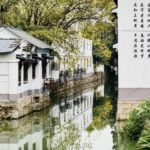Tingfeng Garden, originally the private garden of Wu Yun, the Qing Dynasty’s Suzhou prefect, is now located in the central Qingyuan Fang of Suzhou’s ancient city. Known for its elegant pavilions, clear pools, and tranquil rocks, it is acclaimed as a famous study garden in Wu County. The main hall, ‘Tingfeng Xiandian,’ stands at the heart of the garden, with a courtyard to the north and south.
The southern courtyard is lush with flora and diverse rocks, featuring main structures such as the ‘Daowei Residence,’ ‘Red Leaf Pavilion’ (now known as ‘Dai Shuang Pavilion’), and ‘Shiran Pavilion.’ The northern courtyard boasts a clear pond, with a half-pavilion reflecting the surrounding flora in the water.

During the Tongzhi and Guangxu reigns of the Qing Dynasty, Wu Yun, a native of Huzhou and then the prefect of Suzhou, built his residence here. The garden was named ‘Tingfeng Garden’ due to the presence of ancient maples within. Wu described his residence as: ‘not spacious but with the beauty of flowers and trees.’ He compared it with his own ‘small and subtle’ Quyu Garden. Wu Yun was adept at calligraphy and enjoyed collecting and appreciating bronze inscriptions, with the garden adorned with historical texts and bronze vessels.
Tingfeng Garden: A Historical Private Garden in Suzhou
Tingfeng Garden, originally the private garden of Wu Yun, the Qing Dynasty’s Suzhou prefect, i[...]









